LZ 127 Graf Zeppelin
| LZ 127 Graf Zeppelin | |
|---|---|
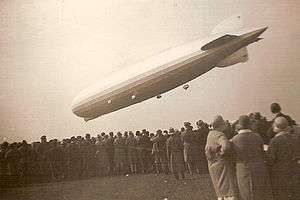 | |
| Role | Passenger/commercial airship |
| National origin | Germany |
| Manufacturer | Luftschiffbau Zeppelin |
| Designer | Ludwig Dürr |
| First flight | 18 September 1928 |
| Introduction | October 11, 1928 |
| Retired | 18 June 1937 |
| Status | Scrapped March 1940 |
| Primary user | DELAG
Deutsche Zeppelin-Reederei |
|
| |
LZ 127 Graf Zeppelin (Deutsches Luftschiff Zeppelin #127; Registration: D-LZ 127) was a German-built and -operated, passenger-carrying, hydrogen-filled, rigid airship which operated commercially from 1928 to 1937. When it entered commercial service in 1928, it became the first commercial passenger transatlantic flight service in the world. It was named after the German pioneer of airships, Ferdinand von Zeppelin, who was a count (Graf) in the German nobility. During its operating life, the airship made 590 flights covering more than 1.7 million kilometers (over 1 million miles). It was designed to be operated by a crew of 36 officers and men. The LZ 127 was the longest rigid airship at the time of its completion and was only surpassed by the USS Akron in 1931. It was scrapped for fighter plane parts in 1940.[1]
Design and development

Built at the Zeppelin Company works (Luftschiffbau Zeppelin) in Friedrichshafen am Bodensee (Lake Constance), Germany, between 1926 and 1928, the LZ-127 had a design patterned on that of the LZ-126, which the company had delivered as a war reparation to the U.S. Navy. The LZ-126 had been delivered at NAS Lakehurst, New Jersey, in October 1924, where it was commissioned as the USS Los Angeles (ZR-3).[2] With that project completed, the Zeppelin company's chairman Dr. Hugo Eckener promptly began a two-year campaign of lobbying the German Government for funds and permission to proceed with construction of a new airship for Germany.[3] Construction began in 1926 with the aid of a government grant although the majority of the necessary 2 million Reichsmarks (RM) in funding would eventually be raised by public subscription.[4] The LZ 127 was completed and launched in September 1928.
At 236.6 m (776 ft) and a total gas volume of 105,000 m3 (3,700,000 cu ft) of which 75,000 m3 (2,600,000 cu ft) was hydrogen carried in 17 "lift gas" cells (Traggaszelle) and 30,000 m3 (1,100,000 cu ft) was Blau gas in 12 "power gas" cells (Kraftgaszelle), the Graf was the largest airship in the world at the time. It was powered by five Maybach VL-2 12-cylinder 550 hp engines that could burn either Blau gas or gasoline.[5]
Although the Graf could achieve a top airspeed of 128 km/h (36 m/s; 80 mph; 69 kn) at its maximum power of 1,980 kW (2,650 hp), its normal operational airspeed was 117 km/h (33 m/s; 73 mph; 63 kn) at a power of 1,600 kW (2,150 hp).[5] Some flights were made using only Blau gas carried in the dozen power gas cells which enabled the airship to cruise for up to 100 hours. Using gasoline alone it was able to cruise for 67 hours, and up to 118 hours using both. The Graf Zeppelin had a total lift capacity of 87,000 kg (192,000 lb) with a usable payload of 15,000 kg (33,000 lb) on a 10,000 km (6,200 mi; 5,400 nmi) flight.[5]
Gondola layout

The flight deck and operational spaces, common areas, passenger cabins, and public toilet facilities on the Graf Zeppelin were all contained in a single contiguous "gondola" structure built into the forward third of the airship's ventral surface. The forward operational spaces consisted of the flight deck, a map/navigation room with two large open access hatches to allow the command crew to communicate with the navigators, radio room, galley, and a short passage to the main entrance-exit door space. An ascending ladder located in the map room allowed access to a keel corridor inside the hull. The map room also had two large windows, one on each side, which permitted navigators to shoot the horizon and sky with a sextant.
Behind the operational spaces were the main dining and sitting room with four large windows which connected via a long corridor to ten passenger cabins capable of sleeping 24, a pair of washrooms, and dual toilet facilities.[6] The passenger cabins were set by day with a sofa which converted to two beds, one above the other, at night.[7] The crew's quarters were located inside the hull and were reached by a catwalk. The galley was equipped with a single electric oven with two compartments and hot plates on top for cooking.[7] One luxury that was not provided on the Graf Zeppelin was heating.[8][9][10]
Electrical and communications systems
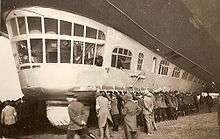
The main generating plant was inside the hull and consisted of two fuel-burning generators.[7] Two small ram air turbines attached to the main gondola on swinging arms supplemented electrical power for the radio room, internal lighting, the galley, and acted as a reserve. Batteries stored the electrical energy so that radio operation was independent of airspeed.[11] The gondola also had a gasoline generator for emergency power.
The Graf was outfitted with the most modern radio equipment then available.[11] A staff of three radio operators communicated with ground stations and ships, performed radio navigation,[11] received weather reports, and sent private telegrams for passengers. A one kilowatt vacuum tube transmitter (about 140 watt antenna power) was used to send telegrams over the low frequency (500–3,000 m) bands.[11] A 70 watt antenna power emergency transmitter was available for both telegraph and radio telephone over 300–1,300 m wavelength bands which could be powered by either batteries or the gasoline generator.[11]
The main antenna consisted of two lead weighted 120-meter-long wires deployed by electric motor or hand crank. The emergency antenna was a 40-meter wire stretched from a ring on the airship hull.[11] Three high-quality, six-tube receivers served the wavelength ranges 120 to 1,200 m (medium frequency), 400 to 4,000 m (low frequency) and 3,000 to 25,000 m (overlapping low frequency and very low frequency).[11] The radio room also had a shortwave receiver for wavelengths 10 to 280 m (high frequency).[11]
A radio direction finder of the kind then used by large passenger ships employed a rotatable loop antenna to determine the airship's position from any two land radio stations or ship-based transmitters from ships with known positions.[11] During the airship's transatlantic flight to the United States in October 1928, the radio room sent 484 private telegrams and 160 press telegrams.[11]
Operational history
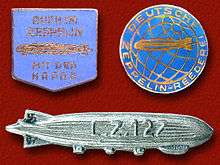
The LZ 127 was christened Graf Zeppelin by Countess Brandenstein-Zeppelin on 8 July 1928, the 90th anniversary of the birth of her father Ferdinand.[12] The Zeppelin Company had originally planned to charter LZ 127 to a Spanish company to carry mail from Seville in Spain to Buenos Aires, Argentina, and a contract was signed just before the first flight of the airship with the intention to carry out test flights between Spain and Argentina in 1929.[13]
The Graf Zeppelin's operational career spanned almost nine years from first flight in September 1928 until its last in June 1937. During that period, the airship was operated first by the Zeppelin Company's commercial flight arm, the Deutsche Luftschiffahrts-Aktiengesellschaft (German Airship Travel Corporation, DELAG) in conjunction with the Hamburg-American Line (HAPAG), and for the final two years by the Deutsche Zeppelin Reederei GmbH (DZR), a company established by Hermann Göring in March 1935 to increase Nazi party influence over Zeppelin operations.[14] The DZR was jointly owned by the Luftschiffbau Zeppelin, the Reichsluftfahrtministerium (German Air Ministry), and Deutsche Lufthansa A.G., Germany's national airline at that time.[N 1]

From 1928 to 1932 the airship was used primarily for experimental and demonstration purposes to prepare the way for eventual regular commercial transatlantic passenger service. After making six domestic shakedown flights, the airship made a first long distance journey in October 1928 crossing the Atlantic to the United States.[15] Later demonstration flights included a round-the-world tour in August 1929, a Europe-Pan American flight in 1930, a polar expedition in 1931, two round trips to the Middle East, and a variety of other flights around Europe. In 1932, however, the Graf Zeppelin began five years of providing regularly scheduled passenger, mail, and freight service between Germany and South America (Brazil). These commercial operations were the airship's principal function during this period until it was abruptly withdrawn from active service on the day after the loss of the Hindenburg in May 1937 after having made a total of 64 round trips to Brazil. During the return trip to Germany on its last South American flight for 1933, the Graf Zeppelin also stopped in Miami (NAS Miami at Opa-Locka), Akron (Goodyear-Zeppelin Company Airdock), and the "Century of Progress" world's fair in Chicago.
Other flights were also made to Spain[16] London,[17] Berlin[18] and Moscow. During one of the Berlin visits a glider that was released from under its hull performed a loop in front of cheering crowds,[19] and on one of the Brazil trips British Pathé News filmed on board.[N 2]

While passengers paid premium fares to fly on the LZ 127 (1,500 RM from Germany to Rio de Janeiro in 1934, equal to then $590 US dollars [21] or $10,600 US dollars in 2016 [22]), with fees collected for both high value freight and air mail provided much if not most of the income needed to support the airship's commercial operations. In one transatlantic flight, for instance, the Graf Zeppelin carried 52,000 postcards and 50,000 covers, and by its last flight it had flown 48,080 kg (106,000 pounds) of mail overall. Since 1912 Zeppelins had been authorized by the German postal administration to postmark and sort mail on board and was able to deliver South America-bound post about a week faster than by ship.[N 3]
During the airship's operational career, the Graf Zeppelin flew more than 1.7 million km (1,056,000 miles), becoming the first aircraft in history to fly over a million miles, made 590 flights, 144 oceanic crossings (143 across the Atlantic, one across the Pacific), carried 13,110 passengers, and spent 17,177 hours aloft (the equivalent of 717 days, or nearly two years), all of which was accomplished without ever injuring a passenger or crewman.[24] Although scrapped in 1940, hundreds of thousands of verifiable philatelic mementos of its career still exist in the form of the flown cacheted and post marked mail carried on hundreds of its flights which are still avidly collected by stamp and postal history enthusiasts worldwide.[25]
Significant flights
First intercontinental flight (1928)

In October 1928 the Graf Zeppelin made its first intercontinental trip, a 9,926 km (6,168 mi), 111-hour crossing from Friedrichshafen to Lakehurst with Dr. Eckener in command. Capt. Ernst Lehmann, who would be killed in the crash of the Hindenburg at Lakehurst eight and a half years later, served as First Officer on the flight and U.S. Navy LCDR Charles E. Rosendahl, commander of the ZR-3 USS Los Angeles (ex-LZ 126), made the westward journey during which he also stood watch as a regular ship's officer.[26] Despite encountering heavy headwinds and stormy weather, Eckener had repeated the success of his first transatlantic crossing four years earlier when he delivered the LZ-126 to the U.S. Navy in October 1924 and was welcomed enthusiastically then both with a "ticker tape" parade in New York and a subsequent invitation to the White House.

On this first transatlantic trip the airship suffered potentially serious damage to its port tail fin on the third day of the flight when a large section of the linen covering was ripped loose while passing through a mid-ocean squall line at night about 1,500 miles (2,400 km) east of Bermuda (35°N, 42°W).[27] With the engines stopped, the ship's riggers did their best to tie down the torn fabric to the framework and sew blankets to the ship's envelope while attempting not to fall to the raging seas below. In the interest of safety, the riggers (including Dr. Eckener's son, Knut) retreated back into the ship whenever it dropped to within a couple of hundred feet of the ocean's surface. This allowed the engines to be restarted to maintain lift.[28]
The Graf crossed the U.S. coast at Cape Charles, Virginia, around 10 am on 15 October, passed over Washington, D.C., at 12:20 pm, Baltimore at 1 pm, Philadelphia at 2:40 pm, New York City at 4 pm, and landed at the Lakehurst Naval Air Station at 5:38 pm.[29] After an almost two-week stay in the United States, during which time its damaged tail was repaired, the Graf left Lakehurst for Germany at 1:24 am on 29 October and arrived back in Friedrichshafen shortly before dawn on 1 November.[30] Grace Marguerite Hay Drummond-Hay, the British journalist, was the first woman to fly transatlantic on the outward leg; Clara Adams become the first female transatlantic ticketed passenger when she traveled on the Graf Zeppelin's return flight.
Mediterranean flights (1929)

In early 1929 the airship made two trips over the Mediterranean. On the first trip to the eastern Mediterranean in late March 1929, it carried 25 passengers and 16,000 letters to make four mail drops at Jaffa, Athens, Budapest and Vienna.[31] The airship flew over Palestine, Egypt and Athens before returning to Friedrichshafen after completing a journey of 5,000 miles (8,000 km) in 81 hours.[32] The second Mediterranean cruise took place in late April, flying over France, Spain, Portugal and Tangier.[33] The airship returned to Friedrichshafen after flying north over Cannes and Lyons in a flight of 57 hours.[34]
The "interrupted flight" (1929)

Although the Graf Zeppelin ultimately had a safe and highly successful active career lasting nearly nine years, it also came close to being lost just seven months after its maiden flight while attempting to make its second trip to the United States in May 1929. Shortly after dark on 16 May, the first night of the flight ("1. Amerikafahrt 1929"), the airship lost power in two of its five engines while over the Mediterranean off the southwest coast of Spain forcing Eckener to abandon the trip and turn back toward Friedrichshafen. Flying against a stiff headwind up the Rhône Valley in France the next afternoon, two of the remaining three engines also failed resulting in a loss of headway and the Graf being pushed backwards toward the sea.
With Eckener desperately looking for a suitable place to force-land the airship, the French Air Ministry reluctantly advised him that he would be permitted to land at the Naval Airship Base at Cuers-Pierrefeu about 10 miles (16 km) from Toulon.[35] There the Graf Zeppelin would be kept in the hangar which had once housed the Dixmude, the former German Navy Zeppelin LZ 114[36] and later the LZ-121, Nordstern, a small commercial airship which the Allies had awarded to France and operated until 1926 as the "Mediterranee".[37] Although barely able to control the Graf on its one remaining engine, Eckener managed to make a difficult but successful emergency night landing at Cuers.[38]
After temporary repairs, the Graf finally returned to Friedrichshafen on 24 May where the engines were completely overhauled. Mail carried on the flight received a one-line rubber stamped notice in German reading "Beförderung verzögert wegen Abbruchs der 1. Amerikafahrt." ("Delivery delayed due to cancellation of the 1st America trip") and were held at Friedrichshafen until 1 August 1929, when the airship made another attempt to cross the Atlantic for Lakehurst, arriving on 4 August. Four days later, the Graf Zeppelin departed Lakehurst for its most daring and famous trip — a four-leg complete circumnavigation of the globe.
Round-the-world flight (1929)
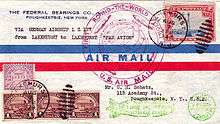
At the behest of American newspaper publisher William Randolph Hearst, whose media empire was the major commercial backer of the project with four staffers among the flight's nine passengers, the Graf's "Round-the-World" (Weltrundfahrt 1929) flight in August 1929 officially began and ended at Lakehurst Naval Air Station in New Jersey.[39] As with many of the airship's other flights, however, its expenses were also heavily offset by the carriage of souvenir mail to and/or from Lakehurst, Friedrichshafen, Tokyo, and Los Angeles. A U.S. franked letter flown on the whole trip from Lakehurst to Lakehurst, for instance, required US$3.55 in postage or the equivalent of roughly $45 in current dollars if based on the CPI.[N 4] The $200,000[39] Hearst paid for exclusive media rights would currently be the equivalent of $2.5 million if figured on the same basis.
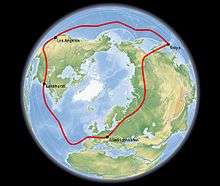
Built in Friedrichshafen, Germany (47°39′14″N 9°28′44″E / 47.654°N 9.479°E)
Started at Lakehurst NAS, USA (40°01′59″N 74°21′13″W / 40.033°N 74.3536°W)
Eastward to Germany (47°39′14″N 9°28′44″E / 47.654°N 9.479°E)
Eastward to Kasumigaura Naval Air Base, Japan (36°03′00″N 140°13′01″E / 36.05°N 140.217°E)
Eastward to Los Angeles (33°56′33″N 118°24′29″W / 33.9425°N 118.408°W), then back to Lakehurst (40°01′59″N 74°21′13″W / 40.033°N 74.3536°W).
Returned to Germany (47°39′14″N 9°28′44″E / 47.654°N 9.479°E)
As with the October 1928 flight to New York, Hearst correspondent Lady Grace Drummond-Hay was on board making her the first woman to circumnavigate the globe by air. Also representing Hearst among the passenger complement were correspondents Karl von Wiegand and Australian Arctic explorer Sir Hubert Wilkins, and photographer/newsreel cameraman Robert Hartmann. The US Government was represented by Naval airshipmen LCDR Charles Rosendahl and LT Jack C. Richardson who flew as official observers.[39][41] A semi-documentary film entitled "Farewell" was released in 2009 which featured much of the newsreel footage of Lady Drummond-Hay shot by Hartmann during the flight. The film was later aired on the BBC under the title "Around The World by Zeppelin".[42]
The Graf Zeppelin flew back across the Atlantic to Friedrichshafen to refuel before continuing across Eastern Europe, the Soviet Union, and the vastness of Siberia to Tokyo (Kasumigaura Naval Air Station) on a 101-hour-49-minute nonstop leg covering 7,297 miles (11,743 km).[41] Although the Soviet government had formally requested by radio to the "Graf" for the airship to overfly its capital, Moscow, Dr. Eckener declined because of the necessity "to take advantage of the tailwinds and remain on the straight airline without deviation or halt" necessary in order to reach Tokyo nonstop, a decision which resulted in considerable disappointment and annoyance on the part of the Soviets.[43] (To make amends for this perceived slight, a year later the "Graf" made a special two-day round trip flight from Friedrichshafen to Moscow on 9–10 September 1930 landing briefly to collect souvenir mail at Moscow's "October Field" (Октябрьское поле) where it was greeted by a crowd of some 100,000 people.[44]) Crossing the inadequately mapped Stanovoy Mountains in Siberia proved to be a precarious venture with the Graf eventually being forced to climb to 6,000 feet in order to clear the range through a high mountain canyon with barely 150 feet to spare.[45] After five days in Tokyo, the Graf continued across the Pacific to California crossing the coast at San Francisco before landing at Mines Field in Los Angeles thus completing the first ever nonstop flight of any kind across the Pacific Ocean, covering 5,986 miles (9,634 km) in 79 hours and 54 minutes.[41][46]
The 4,822 km (2,996 mi; 2,604 nmi), 51-hour-13-minute transcontinental flight across the United States took the Graf over 13 states and such cities as El Paso, Kansas City, Chicago, Cleveland, and Detroit before arriving back at Lakehurst from the west on the morning of 29 August, three weeks after it had departed to the east on 8 August. Flying time for the four Lakehurst to Lakehurst legs was 12 days, 12 hours and 13 minutes while the entire circumnavigation (including stops) took 21 days, 5 hours and 31 minutes and covered 33,234 km (20,651 mi; 17,945 nmi).[41] It was at the time the fastest circumnavigation of the globe.[47]
Germany issued a special commemorative silver 3RM coin in 1930 in recognition of the Graf Zeppelin's historic flight.[48] Dr. Eckener's personal accomplishment received acclaim as well when he became just the tenth recipient (third aviator) in 42 years to be awarded the Gold Medal of the National Geographic Society which was presented to him on 27 March 1930 before a crowd of 5,000 at the Washington Auditorium in Washington, DC. The citation read that Eckener received the award "for his work in furthering the progress of airships, and to commemorate the first around-the-world flight of the Graf Zeppelin."[49] Before returning to Germany Eckener also met with President Herbert Hoover as well as the US Postmaster General whom he successfully lobbied for a special three stamp issue (C-13, 14 & 15) for use on mail to be carried on the Europe-PanAmerican Flight scheduled to leave Germany seven weeks later in mid-May.[50][51]
The Europe-Pan American flight (1930)
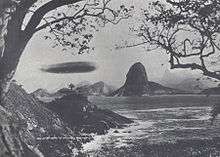
In May 1930 the LZ 127 made its first visit to South America as part of a triangular flight between Spain, Brazil, and the United States. Providing passenger, express freight, and air mail service between Germany, Spain and South America was one function which was an early consideration in the design of LZ-127.[52] It was intended in 1928 to offer passage between Friedrichshafen, Germany, and Rio de Janeiro, Brazil, for 1,500 RM ($356).[53] The 1930 flight originated in Friedrichshafen on 18 May and stopped first in Seville before leaving Europe. The Graf arrived in Brazil first at Recife (Pernambuco) docking at Campo do Jiquiá on 22 May where it was greeted by a crowd of more than 15,000 before preceding on to Rio de Janeiro. The airship then flew back north to Lakehurst, NJ, before heading east over the Atlantic on 2 June to return to Germany with another stop in Seville. This flight led to the establishment two years later of the Graf's regularly scheduled commercial passenger, mail, and freight service between Germany and Brazil which operated from 1932 to May 1937.
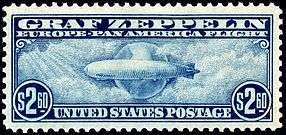
As with so many of its major journeys, the Europe-Pan American flight was largely funded by souvenir mail franked with special stamps issued by Spain, Brazil, and the United States good only for franking mail carried on one or more legs of the trip.[54] The U.S. issued stamps in three denominations: 65¢ (C-13: 1,135,000 printed; approx 20,000 sold/distributed), $1.30 (C-14: 1,005,000; 30,000), and $2.60 (C-14: 1.070.000; 5,000) all three of which were issued on 19 April 1930.
With the US already in the depths of the Great Depression, however, only about 7% of the very expensive stamps that had been produced had been distributed when the issue was withdrawn from sale on 30 June. The more than three million unsold stamps were promptly destroyed by the U.S. Post Office thus making the three Graf Zeppelin issues by far the USPOD's smallest of the 20th Century. Despite the poor sales of these issues, the U.S. Post Office Department nevertheless paid the Zeppelin Company $100,000 for the carriage of U.S. franked mail on the flight.[55]
The Middle East flight (1931)

The Graf Zeppelin had visited Palestine in April 1929 and the second flight to the Middle East took place in 1931 with a flight to Cairo, Egypt, beginning on 9 April and where the airship landed less than two days later. After a brief stop, the Graf Zeppelin proceeded on to Palestine before returning to Friedrichshafen on 13 April, just an hour over four days after departure. The trip took 97 hours, covered 9,000 km (5,600 mi) and crossed 14 countries on three continents.
The polar flight (1931)
The Graf Zeppelin made another groundbreaking flight in July 1931 with a research trip to the Arctic (Polarfahrt 1931). This adventure had been a dream of Count Zeppelin 20 years earlier but could not be realized at the time due to the outbreak of World War I.[56] The idea of using an airship to explore the Arctic was one reason used to justify both the building of Graf Zeppelin, and the restoration of Germany's right to build airships for commercial purposes.[57] A year earlier Dr. Eckener had piloted the Graf on a three-day trip to Norway and Spitsbergen in July 1930 in order to determine its performance in this region. This was followed shortly thereafter by a three-day flight to Iceland. Both trips were completed without technical problems.
The initial idea was to rendezvous with the ill-fated Nautilus, the submarine of polar researcher George Hubert Wilkins, who was attempting a trip under the ice. This plan was abandoned when the submarine encountered recurring technical problems leading to its eventual scuttling in a Bergen fjord.[N 5]
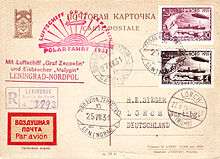
Plans were then altered to make a rendezvous with a surface vessel to be funded by exchanging souvenir mail to the ship. Around fifty thousand cards and letters were collected from around the world weighing a total of about 300 kg (660 lb). The rendezvous vessel, the Soviet icebreaker Malygin, on which the Italian airshipman and polar explorer Umberto Nobile was a guest, carried another 120 kg (260 lb) of mail to exchange. The major costs of the expedition were met largely by sale of special postage stamps issued by both Germany (as overprints) and the Soviet Union to frank the mail carried on the flight. The rest of the funding came from Aeroarctic and the Ullstein-Verlag in exchange for exclusive reporting rights.
The polar flight took one week from 24–31 July 1931. The Graf Zeppelin traveled about 10,600 km (6,600 mi; 5,700 nmi) with the longest leg without refueling being 8,600 km (5,300 mi; 4,600 nmi). The average speed was 88 km/h (24 m/s; 55 mph; 48 kn).
Route:
- Friedrichshafen–Berlin – 600 km (370 mi) in 8 hours (75 km/h; 47 mph)
- Berlin–Leningrad – 1,400 km (870 mi) in 16 hours (87 km/h; 54 mph)
- Leningrad–Kanin – 1,300 km (810 mi) in 12 hours (108 km/h; 67 mph)
- Kanin–Franz-Joseph-Land – 1,200 km (750 mi) in 18 hours (67 km/h; 42 mph)
- Franz-Joseph-Land–Nordland–Taimyr–Novaya Zemlya – 2,400 km (1,500 mi) in 32 hours (75 km/h; 47 mph)
- Novaya Zemlya–Leningrad – 2,300 km (1,400 mi) in 25 hours (92 km/h; 57 mph)
- Leningrad–Berlin – 1,400 km (870 mi) in 13 hours (108 km/h; 67 mph)
- Berlin–Friedrichshafen – 600 km (370 mi) in 8 hours (75 km/h; 47 mph)
Goals:
- Test the Graf Zeppelin under Arctic conditions
- scientific and geographic research of large areas of the Arctic
- measurement of magnetic field changes
- meteorological measurements (including weather balloon launches)
- geo-photographic recording of large areas with a panoramic camera (that would take years if by ship or by land)
All participants were satisfied after the trip: the airship demonstrated its usefulness in the Arctic.
Century of Progress flight (1933)
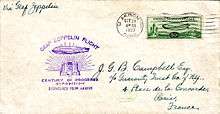
While returning to Germany from Brazil in October 1933, the Graf Zeppelin stopped at Miami (NAS Opa Locka) and then in Akron, Ohio where it visited the Goodyear-Zeppelin Company's massive airdock before proceeding to the Century of Progress World’s Fair in Chicago. After circling over the fair[N 6] and landing for a brief 25-minute visit there, the Graf then returned to Akron for two days before leaving for Friedrichshafen with an overnight stop in Sevilla, Spain. The United States Post Office Department issued a special 50-cent airmail stamp (C-18) to commemorate the visit. Many of these stamps were used to frank souvenir mail carried on the Graf on its return flight to Germany. The visit was also to be the fifth and final one that the LZ 127 would make to the United States.
Die Deutschlandfahrt (1936)
In March 1936 the Graf Zeppelin and the newly launched LZ 129 Hindenburg were impressed by the Reich Ministry for Public Enlightenment and Propaganda (Reichsministerium für Volksaufklärung und Propaganda or Propagandaministerium), as vehicles for the delivery of Nazi propaganda.[60]

On 7 March 1936, ground forces of the German Reich had entered and occupied the Rhineland, a region bordering the Netherlands, Luxembourg, Belgium, and France, which had been designated in the 1920 Treaty of Versailles as a de-militarized zone established to provide a buffer between Germany and those neighboring countries. In order to justify its remilitarization — which was also a violation of the 1925 Locarno Pact,[61] — a "post hoc" plebiscite (or referendum) was quickly called by Hitler for 29 March to "ask the German people" to both ratify the Rhineland’s occupation by the German Army, and to approve a single party list composed exclusively of Nazi candidates to sit in the new Reichstag.
The two airships were designated by the government as a key part of the process by Propaganda Minister Joseph Goebbels who demanded that the Zeppelin Company make both available to fly "in tandem" around Germany over the four-day period prior to the voting with a joint departure from Löwenthal on the morning of 26 March.[62][63] As millions of Germans watched from below, the Graf and Hindenburg sailed over Germany for four days and three nights, dropping propaganda leaflets, blaring martial music and slogans from large loudspeakers, and broadcasting political speeches from a makeshift radio studio on board the Hindenburg.[64]
Commercial operations and forced retirement (1932-1937)
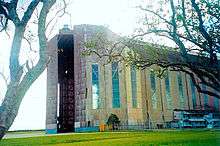
It was in its last five years of service that Graf Zeppelin proved that an intercontinental commercial airship service was possible.[65] For those five years it operated regular scheduled services during the summer season between Germany and South America.[66] The Zeppelin Company built a large hangar in Rio de Janeiro, then Brazil's capital city, the construction of which was subsidized by the Brazilian government. Designed and assembled with parts brought from Germany, the hangar was used only nine times: four by the Graf and five by the LZ-129 Hindenburg.
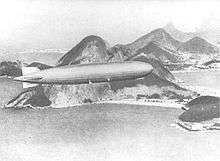
The Graf Zeppelin was too small and slow for the North Atlantic service,[67] yet because of the blau gas fuel, was just capable of carrying out the South Atlantic route.[68] The onset of regular airline service also led to a drastic reduction in the number of flights being made by the airship which, having logged almost 200 flights in 1930-31, made fewer than 60 in 1932.[69]
The loss of the D-LZ 129 Hindenburg at Lakehurst on 6 May 1937 shattered public faith in the safety of hydrogen-filled airships making the continuation of their commercial passenger operations unsustainable unless the Graf Zeppelin and the still under construction LZ 130 Graf Zeppelin II could convert to non-flammable helium, the only alternative lifting gas for airships. Unlike the relatively inexpensive and universally available hydrogen, however, the vast majority of the world's available supplies of the much more costly, less buoyant, and harder to produce helium (which is an extracted byproduct of mined natural gas) were controlled by the United States. Since 1925, the exportation of helium had also been tightly restricted by Congress, although there is no record that the German Government had ever applied for an export license for helium to use in its airships prior to the Hindenburg's crash and fire.[70]
Though much safer than hydrogen, the greatly added expense, lack of availability, and overall degradation in lifting performance that converting to helium would impose on the Graf Zeppelin made its continued operation no longer commercially viable. One day after the Hindenburg crashed in Lakehurst, the nine-year-old LZ 127 was grounded and withdrawn from service on its arrival in Friedrichshafen after a flight from Brazil on 8 May 1937. Six weeks later, on 18 June, the airship was ferried to Frankfurt am Main on what would be its 590th and final flight. On its arrival at its massive hangar at the Frankfurt airport, the airship was deflated and opened to the public as a museum.[71]
The Graf Zeppelin had already been decommissioned and retired after the Hindenburg disaster, when President Roosevelt approved and forwarded a Cabinet report to Congress that supported exporting enough helium to Germany to permit the launched Hindenburg Class LZ-130 Graf Zeppelin II, which was designed to use either hydrogen or helium, to resume commercial transatlantic passenger service by 1939.[72] By early 1938, however, firm opposition by Interior Secretary Harold Ickes, formally made in his capacity of one of the six statutory members of the National Munitions Control Board, to a German request to purchase up to 10,000,000 cubic feet (280,000 m3) of helium made that impossible.[73]
Established by §5(a) of the Neutrality Act of May 1, 1937 (22 U.S.C. 441), the Board (which consisted of the Secretaries of State, War, Navy, Treasury, Commerce, and Interior), was vested by the Act with the ultimate authority to both prohibit the export to "belligerent states, or to a state wherein civil strife exists" of any type of "arms, ammunition, and implements of war" as well as restrict the transfer of any other "articles or materials" such as helium which the Government classified as having "military importance."[74]
At a White House press briefing on 11 May 1938, President Roosevelt's press secretary Stephen Early announced that as the Act required the "unanimous" consent of the Control Board to approve the export of helium to Germany, the President had concluded that he was "without legal power to override the judgment of any one of the six [members] and direct the sale of helium for export." In response to this statement, Dr. Eckener commented later that same day that "should this decision be final, I am afraid it means the death sentence for commercial lighter-than-air craft."[75]
Although the Graf Zeppelin II made 30 test, promotional, propaganda and military surveillance flights around Europe between the airship's launch in mid-September 1938 and its last flight 11 months later on 20 August, made just 10 days before the formal start of World War II in Europe with the German invasion of Poland on 1 September 1939, the LZ 130 never entered the commercial passenger service for which it was built. The ultimate fates of both the original Graf Zeppelin (LZ 127) and the Graf Zeppelin II (LZ 130) were formally sealed on 4 March 1940, when German Air Minister Hermann Göring issued a decree ordering both to be immediately scrapped for salvage and their duralumin airframes and other structures to be melted down for reuse by the German military aircraft industry.[76]
Specifications

ACP = Auxiliary control post
red = AC = axial corridor running from main ring −2 to the front mooring hub
blue = LC = lower corridor running from main ring 20 to ring 211 ending at ladder to axial corridor
orange = WC = crew's toilet
beige = CQ = crew's quarters with tables, chairs and berths
beige = B = berths or cargo space
blue stripes = A = ventilation shaft
green stripes = CS = climbing shaft
brown stripes GE = exhaust gas shaft
brown box = O = oil tanks
yellow box = P = petrol tanks
light blue box = W = water tank
OP = Observation post on top of hull
pink cell = H2 = hydrogen gas cell
magenta cell = BG = Blaugas cell
General characteristics
- Crew: 40
- Capacity: 20 passengers
- Length: 236.53 m (776 ft 0 in)
- Diameter: 30.48 m (100 ft 0 in)
- Volume: 105,000 m3 (3,707,550 ft3)
- Useful lift: 60,000 kg (132,000 lb)
- Powerplant: 5 × Maybach engines, 410 kW (550 hp) each
Performance
- Maximum speed: 128 km/h (80 mph)
See also
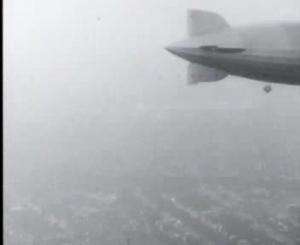
References
Notes
- ↑ Total capital of the company was 9,550,000 Reichsmarks apportioned as follows: Luftshiffbau Zeppelin, 5,700,000; Deutsche Lufthansa for its own account, 400,000 RM; Deutsche Lufthansa in trust for the Air Ministry, 3,450,000 RM
- ↑ "Flying down to Rio" on board the giant liner of the skies, the Graf-Zeppelin."[20]
- ↑ Images and movies on mail and cargo handling with the Graf.[23]
- ↑ Current data is only available till 2007.[40]
- ↑ The scuttling was mandated by US-UK treaty.[58]
- ↑ Footage shows Graf Zeppelin circling then landing.[59]
Citations
- ↑ http://www.airships.net/lz127-graf-zeppelin/history
- ↑ "Flight's End." Time Magazine, 27 October 1924.
- ↑ Archbold 1994, p. 102.
- ↑ "New German Airship - A visit to the works at Friedrichshafen". News. The Times (44851). London. 26 March 1928. col E, p. 8.
- 1 2 3 Scherz 2003
- ↑ Graf Zeppelin Gondola Deck Plan Zeppelin promotional brochure 1934
- 1 2 3 "LZ 127 Graf Zeppelin: Bilder aus dem Luftschiff" (Photograph Elektrozentrale) (in German). Pilot und Luftschiff. Retrieved: 8 August 2011.
- ↑ www.airships.net Retrieved November 4, 2015
- ↑ Over Empires and Oceans: Pioneers, Aviators and Adventurers - Forging the International Air Routes 1918-1939; by Robert Bluffield; page 214
- ↑ Food in the Air and Space: The Surprising History of Food and Drink in the Skies; by Richard Foss; pages 9-10
- 1 2 3 4 5 6 7 8 9 10 Busch 2006
- ↑ "The New Zeppelin". News in Brief. The Times (44941). London. 10 July 1928. col B, p. 15.
- ↑ "New Zeppelin's Flight Postponed. Airship Service To South America". News. The Times (45000). London. 17 September 1928. col C, p. 11.
- ↑ "Deutsche Zeppelin-Reederei (DZR)". Airships.net.
- ↑ Michel, Carolyn. "Round-the-World Flights." wingnet.org.
- ↑ Bomberguy 2008, 08:15 to 09:03.
- ↑ Bomberguy 2008, 07:05 to 08:14.
- ↑ Bomberguy 2008, 09:30.
- ↑ Bomberguy 2008, 09:50 to 10:02.
- ↑ "Graf Zeppelin crossing Atlantic". British Pathé News, 1930– filmed on board last stage of flight to Rio de Janeiro.
- ↑ "Exchange Rates Between the United States Dollar and Forty-one Currencies". MeasuringWorth.com. Retrieved 2014-08-08.
- ↑ "CPI Inflation Calculator".
- ↑ "Luftskibet Kommer" (in German). Post & Tele Museum Danmark.
- ↑ Brewer 1991, p. 2.
- ↑ "Graf Zeppelin Covers" Airships.net
- ↑ Bradley, Samuel S., ed. Aircraft Yearbook 1929. New York: Aeronautical Chamber of Commerce of America, Inc., 1929, pp. 145–146.
- ↑ "Zeppelin Speeds North of Bermuda and is Expected Here This Afternoon; Damaged Fin is Repaired in the Air." The New York Times, 14 October 1928.
- ↑ Vaeth, J. Gordon. "Graf Zeppelin: The Adventures Of An Aerial Globetrotter". New York: Harper & Brothers, 1958. Library Of Congress catalogue number 58-6164.
- ↑ "Zeppelin Safe at Lakehurst after 111-Hour Flight; Soars Over the White House and then Over New York; Moored to Mast till Wind Drops at 2 am; Now in Hangar." The New York Times, 16 October 1928.
- ↑ "Bells, Bands, Guns Welcome Zeppelin: Airplanes Fly Overhead and Searchlights Play on Returning Silvery Aircraft". The New York Times, 2 November 1928, p. 3.
- ↑ "Zeppelin's Flight Over Mediterranean". News. The Times (45160). London. 25 March 1929. col C, p. 12.
- ↑ "Zeppelin's Voyage Ended - 5,000 Miles Flight". News. The Times (45164). London. 30 March 1929. col C, p. 13.
- ↑ "Zeppelin'sFlight - Second Mediterranean Cruise". News in Brief. The Times (45185). London. 24 April 1929. col F, p. 15.
- ↑ "Graf Zeppelin". News in Brief. The Times (45187). London. 26 April 1929. col E, p. 16.
- ↑ Meyer 1991, p. 172.
- ↑ Robinson 1975, p. 345.
- ↑ Robinson 1975, p. 349.
- ↑ "Zeppelin Battles Gale to Safety; Reaches Cuers, France, on One Motor; Eckener and Crew Avert Disaster." The New York Times, 18 May 1929.
- 1 2 3 . "Los Angeles to Lakehurst." Time magazine, 9 September 1929.
- ↑ "Measuring Worth – Relative Value of US Dollars." measuringworth.com.
- 1 2 3 4 Geisenheyer, Max. "Mit 'Graf Zeppelin' Um Die Welt: Ein Bild-Buch". Frankfurter Societäts-Druckerei G.m.b.H., Frankfurt am Mein (Germany), 1929.
- ↑ Buckeridge, Julian. "BAF 2011 Review: Farewell." atthecinema.net, 26 February 2011.
- ↑ Lehmann 1937, p. 291.
- ↑ "Graf Zeppelin Makes First Trip to Moscow: 100,000 Pack October Field to Get View", The New York Times 11 September 1930, p. 5
- ↑ "Zeppelin World Cruise: Globe Trotting Leviathan" Aviation History Magazine, 6 November 2006
- ↑ "Graf Zeppelin Reaches Pacific Coast; Passes San Francisco, Nearing Goal; Thousands Wait at Los Angeles Field". The New York'Times, 26 August 1929, p. 1.
- ↑ "Around the World with the Graf Zeppelin" Modern Mechanics and Inventions, November, 1929. pp. 64-65
- ↑ "Graf Zeppelin Weltflug 1929" commemorative 3 Reichsmark silver coin Staatliche Münzender der Deutsches Reich, Berlin (State Mint of the German Reich), 1930 "A" (Berlin)
- ↑ AERONAUTICS: Zeppelin Pool Time Magazine, 7 April 1930.
- ↑ "Eckener Receives Grographic Medal: 5,000 at Capital Witness the Bestowal of World Honor on Zeppelin Commander." The New York Times, 28 March 1930, p. 6.
- ↑ "Video: Presentation of National Geographic Society Gold Medal to Dr. Hugo Eckener." Universal Newspaper Newsreel, 27 March 1930.
- ↑ Meyer 1991, p. 125.
- ↑ Ventry and Kolesnik 1982, p. 119.
- ↑ "Special U.S. and Foreign Stamps for the First Europe - Pan American Flight of the Airship Graf Zeppelin". Luftschiffbau Zeppelin G.m.b.H. (printed announcement) New York, April 1930
- ↑ Curley, Walter. "The Graf Zeppelin's flights to South America 1930-1937." Cardinal Spellman Philatelic Museum, 1970.
- ↑ "Into The Arctic Waste With The Graf Zeppelin." Popular Mechanics, November 1931.
- ↑ Meyer 1991, p. 161.
- ↑ Ahern, J.J. "Finally sunk on November 20, 1931". The Nautilus, American Philosophical Society, 2000.
- ↑ Bomberguy 2008, from 09:00 to 09:30.
- ↑ "Propaganda 'attack' made by Zeppelins." The New York Times, 29 March 1936.
- ↑ "Belgium Insistent on Locarno Terms." The New York Times, 12 March 1936.
- ↑ "Two Reich Zeppelins on Election Tour." The New York Times, 27 March 1936.
- ↑ "Photograph of the Hindenburg and Graf Zeppelin preparing to depart Löwenthal on Die Deutschlandfahrt." specialcollections.wichita.edu. Retrieved: 11 January 2010.
- ↑ Lehmann 1937, pp. 326–332.
- ↑ Dick and Robinson 1985, p. 41.
- ↑ Brooks 1992, p. 167.
- ↑ Dick and Robinson 1985, p. 83.
- ↑ Dick and Robinson, 1985, p. 76.
- ↑ Syon 2005, p. 143.
- ↑ Krock, Arthur. "In Washington: A Star Witness on Our Helium Export Policy." The New York Times, 12 May 1937, p. 22.
- ↑ "Graf Zeppelin Retired: Dirigible Flies to Hangar at Frankfort to Be Deflated." The New York Times, 20 June 1937, p. 32.
- ↑ "President Backs Export of Helium: Sends to Congress Report by Cabinet Committee Advising Sale for Airship Lines." The New York Times 26 May 1937, p. 2
- ↑ "Ickes Stand Halts Helium Gas Sale: His Opposition, Under Law, Prevents Roosevelt Action to Aid Dirgible." The New York Times, 12 May 1938, p. 9.
- ↑ "(Text of the) Neutrality Act of May 1, 1937, (22 U.S.C. 441)." Ashbrook Center for Public Affairs at Ashland University via TeachingAmericanHistory.org, 2008.
- ↑ "Ickes Stand Halts Helium Gas Sale: His Opposition, Under Law, Prevents Roosevelt Action to Aid Dirgible." The New York Times, 12 May 1938, p. 9.
- ↑ Bauer and Duggan 1994, pp. 173, 189–195.
Bibliography
- Airships.net LZ-127 Graf Zeppelin
- Archbold, Rick. Hindenburg: An Illustrated History. Toronto: Viking Studio/Madison Press, 1994. ISBN 0-670-85225-2.
- Bauer, Manfred and John Duggan. LZ 130 Graf Zeppelin und das Ende der Verkehrsluftschiffahrt. Friedrichshafen, Germany: Zeppelin-Friedrichshafen Museum, 1998, First edition 1994. ISBN 3-926162-79-1.
- Bomberguy. "Graf Zeppelin." Bomberguy Aviation History, selected clips. Retrieved: 11 June 2008.
- Botting, Douglas. Dr. Eckener's Dream Machine: The Great Zeppelin and the Dawn of Air Travel. New York: Henry Holt & Co., 2001. ISBN 0-8050-6458-3.
- Brewer, G. Daniel. Hydrogen Aircraft Technology. Boca Raton, Florida: CRC Press, 1991. ISBN 0-8493-5838-8.
- Brooks, Peter W. Zeppelin: Rigid Airships 1893-1940. Washington, D.C.: Smithsonian Institution Press, 1992. ISBN 1-56098-228-4.
- Busch, Heinrich. Funkverkehr auf dem Luftschiff LZ 127 Graf Zeppeli. (in German), 14 August 2006. Retrieved: 5 July 2008.
- Dick, Harold G. and Douglas H. Robinson.The Golden Age of the Great Passenger Airships Graf Zeppelin & Hindenburg. Washington, D.C. and London: Smithsonian Institution Press, 1985. ISBN 1-56098-219-5.
- Dick, Harold G. with Douglas H. Robinson. Graf Zeppelin & Hindenburg. Washington, D.C.: Smithsonian Institution Press, 1985. ISBN 0-87474-364-8
- Duggan, John. LZ 129 "Hindenburg": The Complete Story. Ickenham, UK: Zeppelin Study Group, 2002. ISBN 0-9514114-8-9.
- Geisenheyner, Max. Mit 'Graf Zeppelin' Um Die Welt: Ein Bild-Buch. (in German) Frankfurt am Mein, Germany: Frankfurter Societäts-Druckerei G.m.b.H., 1929.
- "Honors to Dr. Hugo Eckener: The First Airship Flight Around the World." National Geographic Magazine Vol. LVII, No. 6, June 1930, pp. 653–688.
- Horton, Edward. The Age of the Airship. Glasgow: Sidgwick & Jackson, 1973. ISBN 0-283-97930-5.
- Lehmann, Ernst. Zeppelin: The Story of Lighter-than-air Craft. London: Longmans, Green and Co., 1937.
- Meyer, Henry Cord. Airshipmen Businessmen and Politics 1890-1940. Washington, D.C.: Smithsonian Institution Press, 1991. ISBN 1-56098-031-1.
- Provan, John. LZ-127 "Graf Zeppelin": The story of an Airship, vol. 1 & vol. 2 (Amazon Kindle ebook). Pueblo, Colorado: Luftschiff Zeppelin Collection, 2011.
- "Zeppelin Airships 1918–1940." Puget Sound Airship Society, 2007. Retrieved: 5 July 2008.
- Robinson, Douglas H. Giants in the Sky. Seattle:, University of Washington Press, 1975. ISBN 0-295-95249-0.
- Scherz, Walter. Bau und Einrichtung des Luftschiffes "Graf Zeppelin" (in German)- LZ127 in construction." JADU, 2003. Retrieved: 2 June 2008.
<sup class="noprint Inline-Template "noprint Inline-Template"" style="white-space:nowrap;">[check quotation syntax]* Syon, Gillaume de. Zeppelin! Germany and the Airship, 1900-1939. Baltimore, Maryland: Johns Hopkins University Press, 2005. ISBN 0-8018-6734-7.
- Ventry, Lord and Eugene M. Kolesnik. Airship Saga. Poole & Dorset, UK: Blanford Press, 1982. ISBN 0-7137-1001-2.<
External links
| Wikimedia Commons has media related to LZ 127 Graf Zeppelin. |
- Airships.net LZ-127 Graf Zeppelin
- "With The Graf Zeppelin", Popular Mechanics, November 1929, a 16 page article with photos and drawings
- Graf Zeppelin Floats Over U.S. Capitol
- Photographs of interior and exterior of Graf Zeppelin
- Private photographs of Graf Zeppelin over Chicago’s World’s Fair, 1933
- The Graf Zeppelin
- "The history and building of the Zeppelin" (Dutch) (youtube video, 5 minutes). Nyo Visuals [Elsbeth van Noppen]. Retrieved: 20 February 2009.
- "Graf Zeppelin ends world flight." (1 minute 17 seconds video: aeroplane escort, Lakehurst hangar). Universal Newspaper Newsreel. Retrieved: 20 February 2009.
- Four pictures from Graf Zeppelin´s flight over Bergen Norway on flickr commons
- Photographs of Graf Zeppelin at Hanworth Air Field watched by local scouts